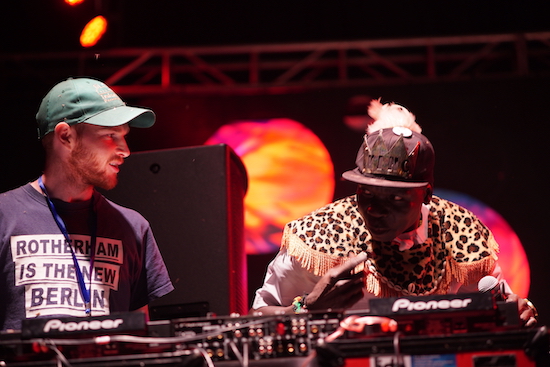There’s a frantic, jittery energy to Rian Treanor’s music. Released by Planet Mu in 2020, the Yorkshireman’s second full length album, File Under UK Metaplasm, garnered significant praise as one of the year’s most interesting records. Peeking out at an unrelenting 180 bpm, tracks veer between potent singeli, slick, high-def bass, hyperchromatic UK garage and pointillistic footwork. Hearing the single ‘Hypnic Jerks’ in the midst of lockdown, I was transfixed. Through headphones, the listening experience is akin to being pelted with globules of electrified water while machine-gun kicks and acidic screeches detonate in either ear.
Far from slowing down, if anything, Saccades sees the ambitious producer reach unparalleled levels of frenzy. The album is made in collaboration with master Acholi fiddle player Ocen James, a member of the Nyege Nyege collective, who works with traditional instruments playing Udungu, Naga and Rigirgi music. He is also a pioneer of Acholitronix, an electronic remaking of Acholi ceremonial songs. The pair have been a joint force for a few years already, with Treanor even citing his time performing with James in Uganda as amongst File Under UK Metaplasm’s inspirations. Perhaps this is why, then, Saccades ascends to such liquid intensity. Structured around interlocking polyrhythms and asymmetrical Euclidean patterns, the percussive vehemence is there from the very first bars where a furious clammer announces the album’s opening.
What is different, however, is while Treanor’s previous productions have been uniquely computerised, the fiddle adds an intoxicating organic component. The resulting tracks are like a score for an Ursula K. Le Guin novel – folkloric-futuristic medleys that combine both the ancient and unplaceable. Take ‘Rigi Rigi’ in which a hyperactive pulse meets James’ jaunty strings. The song is reminiscent of a speedway rework of Caspa’s 2006 orchestral dubstep anthem ‘Cockney Violin’, only far rawer and weirder. Or the opener ‘Bunga Bule’ where a cacophony of percussion – bells, handpan drumbeats and unidentifiable whistles – meld with surgically spliced-up vocals emulating screaming robot birds and jittering animals.
It would have been too easy to simply sample James, reworking the snippets into dancefloor-friendly compositions. That, after all, has already been done to death. Rather, what comes across on Saccades is a fusion of complimentary synergies. The album has a genuinely improvised feel as the two artists push each other’s idiosyncrasies into opposing directions. At various points, it’s truly difficult to discern whether processed or organic sounds are being played. Akin to the avant-garde saxophonist Bendik Giske, James seems to have the uncanny ability to emulate electronica, coaxing synthetic shrieks or metallic whirls out of the body of his instrument.
By contrast the mechanic kicks and cyborg sub-bass that personified File Under UK Metaplasm are somewhat mutated – this is no longer just the machines speaking. Hoping to capture the tactility of a live performance, in his usual working style of custom-making his own sound design tools, Treanor developed a digital process that would synchronise with James’ approach. Using modelling techniques, he assembled a new, hybrid instrument that explored the tunings of the a’dungu, an arched harp, and the nah or nag. With James playing his rigi rigi, a single string violin, together they experimented with the spectral properties of sound, using texture and acoustic contours as their structural framework. Rooted in Ugandan culture and an East African context, Saccades shuttles into alternative dimensions of noise, computer music and radical UK rave.
In this sense, Saccades doesn’t so much as follow the hardcore continuum as set it on fire. Jungle’s potent kickdrum explodes on the opening bars of ‘Tiyo ki’ before the paranoid beat disintegrates into shuffling footwork, a reedy instrument growling like a demonic chainsaw. Techno pulsations echo on ‘Naasaccade’ as if the track was recorded in a dripping underground cavern, while the microtonal twang of ‘Memory Pressure’ resembles an electroacoustic nightmare. If previously Treanor has stated that he is interested in the limits of dance music, finding the precipice of what would be unplayable in a club context, then he has certainly reached that goal. Still, it’s hugely satisfying to imagine a DJ wielding a song like ‘As It Happens’, maybe even re-inventing its sparse jolts of experimental noise with multiple layers, effects or loops in an act that Treanor himself would surely approve of.
In a contemporary electronic landscape that frequently feels saturated by nostalgia, if nothing else, Saccades is a breath of fresh air. As ever, Treanor’s maniacal accomplishment with avant-garde beat patterns shines through. The young producer’s complex composing method involves designing systems to explore extended rhythmic techniques. Taking up the Max/MSP interface, he uses algorithmic processes – the kind which are mostly found in academic, theoretical contexts – to generate spontaneous and impulsive pattern modulation.
Amidst recent remonstrances warning of the detrimental effects of AI, it’s refreshing to hear an artist utilise related technology in a way that seems to be not only creatively beneficial but also mind-expandingly innovative. While it’s important to approach such arguments with nuance, a Luddite philosophy that is wholly wary of future tech’s potentialities won’t do either. Clearly, in the right hands, the possibilities are near endless.
Saccades is truly human dance music – a symbiotic collaboration between interfaces, musicians, instruments and cultures. Nowhere does that better resonate than on the final track ‘Remo Rom’, remixed by Farmers Manual. The Austrian electronic experimentalists punctuate the intimacy of Ugandan folk singers with burbling, obverse rhythmic structures and blasts of noise and distortion. The racket is hypnotic – a Frankenstein mess that lumbers towards the edge of musical intelligibility before falling apart under its own weight.


